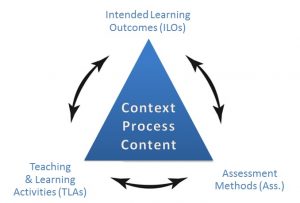Designing Education
When it comes to course design, the most fundamental and central tool is the theory of constructive alignment (CoAl).
This page intends to give a short, non-exhaustive overview of different instructional approaches that can be used to facilitate learning and assessment. We have structured this page based on the theory of CoAl, in order to facilitate your design process by means of these steps.
Constructive Alignment is a framework to realise education in which intended learning outcomes (ILOs), teaching and learning activities (TLAs) and assessment (Ass.) are aligned.
In each section you can find examples for e.g. different learning activities or assessment formats. At the end of the page, you can find an example of an overall redesign-guide.

ILOs
The first step in the design of constructively aligned teaching and assessment is defining intended learning outcomes (ILOs).
Well formulated ILOs lie at the basis of any learning process and appear in course and educational programme descriptions. Once you are given the task to design ILOs, you will find out that it is very difficult to formulate them. It is much easier to formulate the topics to be studied, but if you have to define the exact level to which the topic is to be studied, and if you need to define exactly what a student should be able to do, if true understanding of the topic is achieved, it becomes complicated.
TLAs
The Teaching and Learning Activities should be chosen as an appropriate means toward achieving the ILOs that were defined in the first step. A teaching method is appropriate if it enables students to practice exactly those skills or cognitive processes which they need to achieve the intended learning outcomes. Students will be more motivated as they perceive the activity as meaningful.
Assessment
The assessment method is the final part of the three step approach and will determine for a large part if and how students engage in teaching and learning activities. Any teacher will probably recognize questions such as “Is this part of the exam?’’
Initially this sounds as a negative element. However, it can be beneficial if it’s constructively aligned with the ILOs and the TLAs. Hence, the assessment method (a) stimulates to participate in the teaching and learning activities, and (b) measures to what extent the intended learning outcomes are achieved.
Examples for course (re-)design
The information on this page is structured according to the Theory of Constructive Alignment. The pages linked under each section offers many examples and best practices. In this section we’re linking to two guides: one is an example of programmatic redesign that can be transferred to the course level and includes possibilities for minor to major revisions; the other is an example guide that was provided in the context of the shift to emergency remote learning in the COVID-19 pandemic. In addition, we are currently working on a course redesign guide.
For more specific example, please check out the specific sections as outlined above. You can, e.g. find great examples of assessment formats under the section: Assessment Course Level.
Information literacy
The UM library website offers information on a framework to improve information literacy skills, including online modules for self-study and/or use within the curriculum
